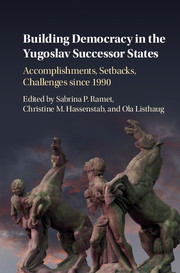 Building Democracy in the Yugoslav Successor States
Building Democracy in the Yugoslav Successor States Book contents
- Frontmatter
- Dedication
- Contents
- List of Boxes
- List of Figures
- List of Tables
- Notes on Editors
- Notes on Contributors
- Preface
- Part I Introduction and Theory
- Part II Country Studies
- 7 Building Democracy in Serbia: One Step Forward, Three Steps Back
- 8 Building Democracy in Croatia since 1990
- 9 A Durable Oligarchy: Bosnia and Herzegovina's False Post-War Democratic Transition
- 10 Liberal Democracy in Slovenia: From Seventh Heaven to the Lobby of Hell in Only Two Decades?
- 11 Macedonia's Post-Yugoslav Reality: Corruption, Wiretapping, and Stolen Elections
- 12 Building Democracy in the Western Balkans: The Case of Kosovo
- 13 The Trajectory and Parameters of Democratic Transition in Montenegro
- 14 Building Democracy in Vojvodina
- Part III Conclusion
- Further Reading
- Index
13 - The Trajectory and Parameters of Democratic Transition in Montenegro
from Part II - Country Studies
Published online by Cambridge University Press: 25 May 2017
- Frontmatter
- Dedication
- Contents
- List of Boxes
- List of Figures
- List of Tables
- Notes on Editors
- Notes on Contributors
- Preface
- Part I Introduction and Theory
- Part II Country Studies
- 7 Building Democracy in Serbia: One Step Forward, Three Steps Back
- 8 Building Democracy in Croatia since 1990
- 9 A Durable Oligarchy: Bosnia and Herzegovina's False Post-War Democratic Transition
- 10 Liberal Democracy in Slovenia: From Seventh Heaven to the Lobby of Hell in Only Two Decades?
- 11 Macedonia's Post-Yugoslav Reality: Corruption, Wiretapping, and Stolen Elections
- 12 Building Democracy in the Western Balkans: The Case of Kosovo
- 13 The Trajectory and Parameters of Democratic Transition in Montenegro
- 14 Building Democracy in Vojvodina
- Part III Conclusion
- Further Reading
- Index
Summary
On 21 May 2006 an independence referendum was held in Montenegro to determine whether the republic would remain a partner within the state union of Serbia and Montenegro (created as a consequence of the March 2002 “Belgrade Agreement”) or become a sovereign and independent state. The referendum, which was brokered by the European Union (EU), saw a narrow majority of 55.5 per cent (the threshold was set at 55 per cent) of the republic's citizens opt for the latter, heralding Montenegro's re-emergence as an internationally recognized independent state. The referendum process was deemed by the Organisation for Security and Co-operation in Europe (OSCE) to be “free and fair,” but was not entirely bereft of controversy. The “Yes” and “No” campaigns had been bitterly fought by the respective blocs advocating these options (accusations of voting irregularities, coercion of the media, and voter manipulation were commonplace). There were political casualties, winners and losers, and the country entered into this new era with a divided body politic and a sense of embitterment among a significant minority (44.5 per cent of the population had voted to retain the joint state), some of whom did not recognize the legitimacy of the result.
On 3 June 2006, independence was formally declared and thus the issue of the republic's status, which had dominated Montenegrin politics since 1997 (but most acutely since the signing of the Belgrade Agreement in March 2003), was finally resolved. But with independence came new uncertainties. The challenges presented were no longer abstract, and the Montenegrin government could no longer blame all their misfortunes on political, economic, or social instability in Serbia, and they could no longer argue that they were inhibited as a result of being tied to Serbia in an asymmetric union in which they were disadvantaged.
Montenegro has, despite the flux it has experienced in the past two decades, made notable progress. The country became a member of the United Nations (UN) and other international institutions while consolidating its position among its neighbors. It has made great strides toward achieving the government's core objective – Euro-Atlantic integration.
- Type
- Chapter
- Information
- Building Democracy in the Yugoslav Successor StatesAccomplishments, Setbacks, and Challenges since 1990, pp. 345 - 368Publisher: Cambridge University PressPrint publication year: 2017
- 6
- Cited by


